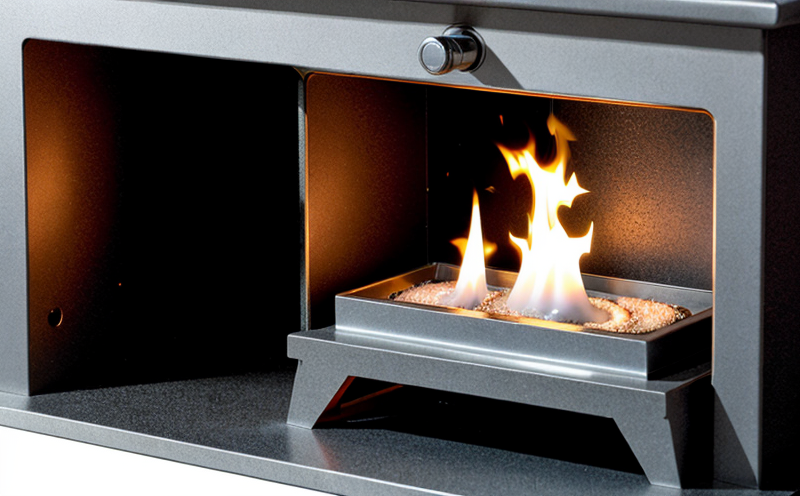NFPA 255 Steiner Tunnel Test for Flame Spread
The NFPA 255 Steiner tunnel test is a critical procedure used to evaluate the flame spread characteristics of materials and products. This standardized method assesses how well materials resist catching fire, remain stable when exposed to flames, and prevent spreading those flames across their surfaces. The test is particularly useful for materials that are exposed to open flames or environments where there is a risk of ignition.
The Steiner tunnel consists of an insulated chamber with a length of 14 meters, divided into three sections: preheating zone, tunnel section, and post-tunnel zone. A gas-fired burner simulates the flame front, which moves through the tunnel at a controlled speed. Specimens are placed on a horizontal surface in the tunnel, where they are exposed to the flame for a specified duration.
The test measures two key parameters: the flame spread index (FSI) and char depth. The FSI ranges from 0 to 100, with lower values indicating better fire performance. Char depth is measured at one-third, two-thirds, and end of specimen length. This metric provides insight into how much of a material chars during exposure to flames.
The NFPA 255 test is widely used in industries such as textiles, furniture, building materials, and automotive interiors. Compliance with this standard ensures that products meet safety requirements for various applications where fire resistance is critical. For example, in the case of upholstered furniture or interior decorations, the results can influence consumer safety by preventing potential fires.
The test procedure involves meticulous preparation of specimens, which must be cut to specific dimensions and thicknesses. This process ensures that each specimen is consistent with others being tested under the same conditions. The apparatus used in NFPA 255 includes a Steiner tunnel furnace, a gas-fired burner, and automated timers to ensure accurate measurements.
After testing, detailed reports are generated summarizing the flame spread index, char depth, and other relevant data. These reports are crucial for quality control and compliance verification. They also serve as valuable technical documentation for product development and improvement efforts.
The NFPA 255 test is not only about meeting regulatory requirements but also about enhancing product safety. By incorporating this testing into the design process early on, manufacturers can identify potential issues and make necessary adjustments before products reach the market. This proactive approach helps prevent costly recalls and ensures that all stakeholders—manufacturers, suppliers, and end-users—are protected against fire hazards.
Why It Matters
The NFPA 255 Steiner tunnel test is essential for several reasons. Firstly, it provides a standardized method to assess the flammability of materials, which is critical in preventing fires and minimizing their spread. This is particularly important in high-risk areas such as industrial facilities, public buildings, and residential homes.
- Regulatory Compliance: Many jurisdictions require compliance with NFPA 255 for certain classes of products. Adherence to this standard ensures that manufacturers can meet legal requirements and avoid costly penalties or market disruptions.
- Safety Assurance: The test results provide assurance that materials will perform reliably under fire conditions, thereby reducing the risk of ignition and subsequent spread of flames.
- Product Quality: By incorporating NFPA 255 into product development processes, manufacturers can improve material performance, leading to higher-quality products. This translates to better overall safety and user experience.
The test also plays a vital role in research and development (R&D) efforts by providing valuable data that can be used to refine materials and processes. For example, the results from NFPA 255 testing can guide engineers in selecting appropriate flame retardants or designing more fire-resistant structures.
Quality and Reliability Assurance
- Consistent Testing: The NFPA 255 test is designed to be repeatable, ensuring that the results are consistent across different laboratories. This consistency is crucial for maintaining reliability in fire safety assessments.
- Automated Equipment: The use of automated timers and gas-fired burners minimizes human error and ensures precise control over testing conditions. This contributes to accurate and reliable test results.
The testing process involves several steps that ensure quality and reliability. Specimens must be prepared according to strict specifications, which include cutting them into specific dimensions and ensuring they are free from defects that could affect the outcome of the test. The Steiner tunnel itself is calibrated regularly to maintain accurate flame exposure.
Post-testing analysis also plays a crucial role in ensuring quality. Detailed reports are generated for each specimen tested, providing comprehensive data on flame spread index, char depth, and other relevant parameters. These reports undergo rigorous review by qualified personnel before being approved as final results.
Customer Impact and Satisfaction
- Informed Decision-Making: By using NFPA 255 testing in their supply chain, customers can make informed decisions about the fire safety of materials. This transparency builds trust between suppliers and buyers.
- Avoiding Risks: Ensuring compliance with this standard helps customers avoid potential risks associated with non-compliant products. This reduces liability for both manufacturers and end-users.
The impact of NFPA 255 testing extends beyond individual companies to affect broader communities. By incorporating these tests into their product development processes, manufacturers contribute to safer environments for all stakeholders involved. For instance, in the case of furniture manufacturers, compliance with this standard can significantly reduce the risk of fire-related accidents in homes and public spaces.
Customer satisfaction is enhanced when suppliers provide reliable data from NFPA 255 testing. This not only meets regulatory requirements but also demonstrates a commitment to quality and safety. Satisfied customers are more likely to recommend products and services, fostering long-term business relationships.





